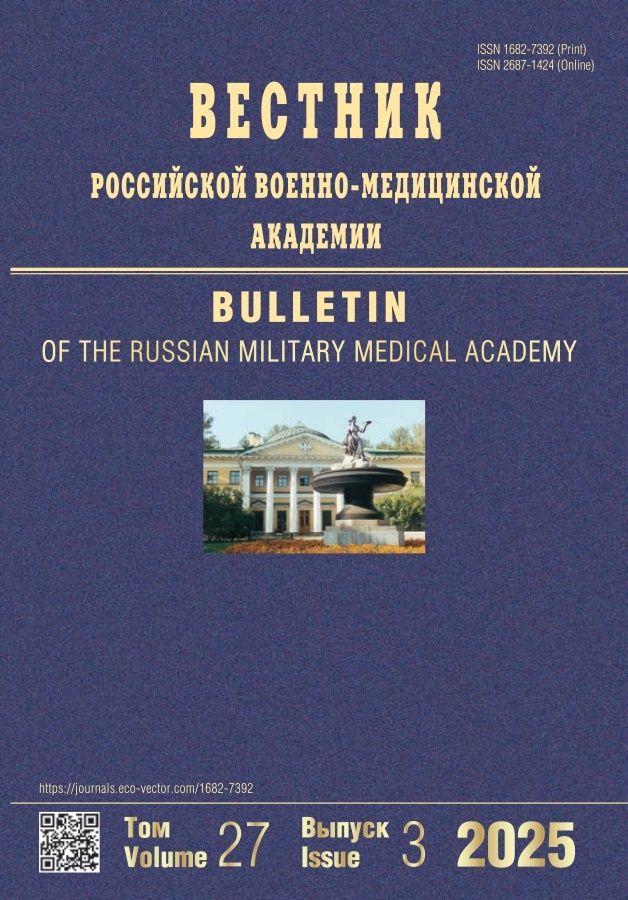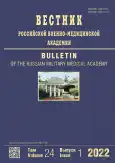Особенности микроциркуляции и метаболизма в коже и мягких тканях области повреждения при экспериментальной взрывной травме
- Авторы: Шперлинг И.А.1, Ростовцев С.О.1,2, Шулепов А.В.1, Коуров А.С.1,3, Баженов М.В.1
-
Учреждения:
- Государственный научно-исследовательский испытательный институт военной медицины МО РФ
- Военная академия материально-технического обеспечения имени генерала армии А.В. Хрулева МО РФ
- Санкт-Петербургский научно-исследовательский институт скорой помощи им. И.И. Джанелидзе
- Выпуск: Том 24, № 1 (2022)
- Страницы: 101-110
- Раздел: Оригинальное исследование
- URL: https://journals.rcsi.science/1682-7392/article/view/71464
- DOI: https://doi.org/10.17816/brmma71464
- ID: 71464
Цитировать
Аннотация
Оценены сроки, характер и продолжительность изменений микроциркуляции и метаболизма, а также их различия в коже и мышечной ткани области повреждения при экспериментальном взрывном повреждении у крыс в различные фазы течения раневого процесса. Экспериментальное взрывное повреждение моделировалось на 30 крысах линии Вистар. Оценивалось общее состояние крыс, их активность, интерес к пище и воде, площадь раны с расчетом характерного времени заживления раны, объем поврежденной тазовой конечности, изменения микроциркуляции и метаболизма в коже и скелетных мышцах паравульнарной области. Установлено, что взрывное повреждение привело к ухудшению микроциркуляции и метаболизма в коже и особенно в мышцах области повреждения. Ухудшение микроциркуляции по сравнению с животными интактной группы выразилось в снижении показателя постоянной составляющей перфузии в коже и мышцах на 57,6 и 40,9% и уменьшением флакса на 76,9 и 76,5% соответственно (р < 0,05). А также в снижении в коже и мышцах флуоресцентного показателя потребления кислорода на 25,7 и 51,8% и комплексного показателя эффективного кислородного обмена на 81,1 и 91,9% соответственно (р < 0,05) В ходе эксперимента отмечалось постепенное восстановление микроциркуляции и метаболизма, более выраженное в коже, за исключением повторного ухудшения внесосудистой регуляции микрокровотока в мышце (снижение флакса на 29,3% от нормы, р < 0,05). Изменения основных показателей микроциркуляции и метаболизма указывают на нормальное заживление кожного дефекта и неудовлетворительное восстановление дефекта мышцы (снижение объема поврежденной конечности (68% от нормы, р < 0,05), сопровождаемого рецидивом внесосудистых нарушений в мышце. В связи со снижением интенсивности восстановительных процессов в мышцах при взрывном повреждении, возникает необходимость разработки новых и совершенствование уже существующих способов доставки в ранние сроки после травмы в область мышечного повреждения биологически активных средств и лекарственных препаратов, которые способны усилить локальный кровоток и создать условия для регенерации поврежденных мышц, сократить сроки заживления раны без формирования патологических рубцов.
Полный текст
Открыть статью на сайте журналаОб авторах
Игорь Алексеевич Шперлинг
Государственный научно-исследовательский испытательный институт военной медицины МО РФ
Email: gniiivm_2@mil.ru
ORCID iD: 0000-0002-7029-8602
SPIN-код: 7730-4120
доктор медицинских наук, профессор
Россия, Санкт-ПетербургСергей Олегович Ростовцев
Государственный научно-исследовательский испытательный институт военной медицины МО РФ; Военная академия материально-технического обеспечения имени генерала армии А.В. Хрулева МО РФ
Автор, ответственный за переписку.
Email: chitah_serge@live.com
ORCID iD: 0000-0002-1037-5848
SPIN-код: 7978-5734
соискатель
Россия, Санкт-Петербург; Санкт-ПетербургАлександр Васильевич Шулепов
Государственный научно-исследовательский испытательный институт военной медицины МО РФ
Email: gniiivm_2@mil.ru
ORCID iD: 0000-0002-6134-809X
SPIN-код: 6197-0036
кандидат медицинских наук
Россия, Санкт-ПетербургАнтон Сергеевич Коуров
Государственный научно-исследовательский испытательный институт военной медицины МО РФ; Санкт-Петербургский научно-исследовательский институт скорой помощи им. И.И. Джанелидзе
Email: gniiivm_2@mil.ru
ORCID iD: 0000-0001-6905-2501
SPIN-код: 4833-8746
соискатель
Россия, Санкт-Петербург; Санкт-ПетербургМихаил Васильевич Баженов
Государственный научно-исследовательский испытательный институт военной медицины МО РФ
Email: gniiivm_2@mil.ru
ORCID iD: 0000-0003-2201-3948
SPIN-код: 5806-5250
начальник госпиталя
Россия, Санкт-ПетербургСписок литературы
- Анисин А.В., Денисов А.В., Божченко А.П., и др. Особенности взрывной травмы нижних конечностей, защищенных обувью сапера // Судебно-медицинская экспертиза. 2020. Т. 63, № 5. С. 13–17. doi: 10.17116/-SUDMED20206305113
- Саввин Ю.Н., Шабанов В.Э., Петлах В.И. Структура санитарных потерь и особенности оказания медицинской помощи населению, пострадавшему при ведении боевых действий в зоне локального вооруженного конфликта // Медицина катастроф. 2019. № 3. С. 21–26. doi: 10.33266/2070-1004-2019-3-21-26
- Саввин Ю.Н., Кудрявцев Б.П. Организация оказания хирургической помощи при минно-взрывных повреждениях в чрезвычайных ситуациях: учебное пособие для врачей. Москва: Защита, 2016. 35 с.
- Айдаров В.И., Малеев М.В., Красильников В.И., Хасанов Э.Р. Экстренная неотложная помощь пострадавшим от взрывных поражений // Практическая медицина. 2019. Т. 17, № 6-2. С. 6–9. doi: 10.32000/2072-1757-2019-6-6-9
- Попов В.Л. Некоторые теоретические проблемы судебно-медицинской экспертизы взрывной травмы // Судебно-медицинская экспертиза. 2015. Т. 58, № 4. С. 4–10. doi: 10.17116/SUDMED20155844-10
- Денисов А.В., Анисин А.В., Божченко А.П., и др. Повреждающие факторы боеприпасов взрывного действия // Вестник Российской военно-медицинской академии. 2017. Т. 19, № 4. С. 180–185.
- Нечаев Э.А., Грицанов А.И., Фомин Н.Ф. Минно-взрывная травма. Санкт-Петербург: Альд, 1994. 487 с.
- Трухан А.П., Самохвалов И.М., Скакунова Т.Ю., Ряднов А.А. Структура повреждений у пострадавших со взрывной травмой мирного времени: террористический акт в метро Санкт-Петербурга 3 апреля 2017 г. // Медицина катастроф. 2020. № 2. С. 29–31. doi: 10.33266/2070-1004-2020-2-29-31
- Сорока В.В. Взрывная травма. Что делать? Санкт-Петербург: Береста, 2015. 488 с.
- Военно-полевая хирургия локальных войн и вооруженных конфликтов: руководство для врачей / под ред. Е.К. Гуманенко, И.М. Самохвалова. Москва: ГЭОТАР-Медиа, 2011. 672 с.
- Травматология: национальное руководство / под ред. Г.П. Котельникова, С.П. Миронова. Москва: ГЭОТАР-Медиа, 2017. 528 с.
- Васягин С.Н., Шперлинг Н.В., Юдин А.Б., и др. Динамика микроциркуляторных нарушений в огнестрельной ране под влиянием экспериментального перевязочного материала с наноструктурированными медью и серебром (экспериментальное исследование) // Крымский журнал экспериментальной и клинической медицины. 2017. Т. 7, № 1. С. 4–10.
- Шперлинг И.А., Шулепов А.В., Шперлинг Н.В., и др. Саногенетические и фармакологические эффекты локального применения гиалуроновой кислоты при экспериментальной компрессионной травме мягких тканей // Крымский журнал экспериментальной и клинической медицины. 2020. Т. 10, № 2. С. 53–60. doi: 10.37279/2224-6444-2020-10-2-53-60
- Fox C.J., Gillespie D.L., O’Donnell S.D., et al. Contemporary management of wartime vascular trauma // J Vasc Surg. 2005. Vol. 41. No. 4. P. 638–644. doi: 10.1016/J.JVS.2005.01.010
- Шперлинг И.А., Заргарова Н.И., Шулепов А.В., и др. Особенности обезболивания при моделировании взрывной травмы у крыс // Восьмая конференция Rus-LASA. 1–3 октября 2020 г. Пущино. С. 47–48.
- Савченко Ю.П., Федосов С.Р. Методы определения размеров раневой поверхности // Вестник хирургии им. И.И. Грекова. 2007. Т. 166, № 1. С. 102–105.
- Аралова М.В., Глухов А.А., Остроушко А.П. Кинетика раневого процесса при различных методах стимуляции регенерации в ранах // Вестник экспериментальной и клинической хирургии. 2018. Т. 11, № 3. С. 173–178. doi: 10.18499/2070-478X-2018-11-3-173-178
- Лукина М.М., Ширманова М.В., Сергеева Т.Ф., Загайнова Е.В. Метаболический имиджинг в исследовании онкологических процессов (обзор) // Cовременные технологии в медицине. 2016. T. 8, № 4. C. 113–128. doi: 10.17691/STM2016.8.4.16
- Cannon T.M., Shah A.T., Walsh A.J., Skala M.C. High-throughput measurements of the optical redox ratio using a commercial microplate reader // J Biomed Opt. 2015. Vol. 20. No. 1. P. 10–13. doi: 10.1117/1.JBO.20.1.010503
Дополнительные файлы












